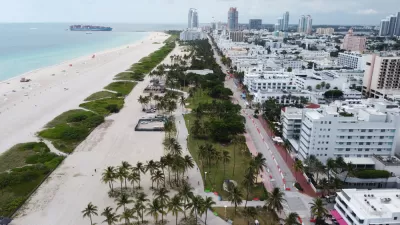In an effort to create safer walking and biking environments, Miami-Dade counties have built bike lanes along two highways connecting the Miami with its eastern island beaches, reducing travel distances by 75 percent for cyclists.
As covered by Tanya Snyder on Streetsblog USA, after years of being ranked the most dangerous state in the United States for walking and bicycling, "state Transportation Secretary Ananth Prasad launched the Bicycle/Pedestrian Focused Initiative and the state is beginning to build more bike lanes and other infrastructure for safe biking and walking. And the experiment in accommodating active transportation on these limited-access bridges is a bold attempt to correct the errors of the past."
Aiming to make cheap retrofits to the existing shoulders on these six-lane, 55 mile-per-hour highways, the "pilot project cost under a million dollars for the two Miami-Dade County bridges together. The most expensive part was adding a hand railing to the wall at the edge of the bridge — there’s no wall between the bikes and the cars. In some cases FDOT and its team painted sharrows and crossings for cyclists to navigate tricky areas like on-ramps, sometimes they added green paint to point out conflict zones. They added rumble strips and striping that would vibrate and make noise if drivers veered out of their lane. They replaced some drainage grates with ones that wouldn’t be dangerous to bike tires."
Many cyclists illegally rode these causeways before the improvements. With the retrofits, cyclist ridership has increased along these highways, with a 40 percent increase in bicycle trips on the William Lehman Causeway, and a 167 percent uptick on weekdays and a 68 percent increase on weekends along the Julia Tuttle Causeway.
FULL STORY: Complete Freeways? Florida Tries Bike Lanes on Highway Bridges

Alabama: Trump Terminates Settlements for Black Communities Harmed By Raw Sewage
Trump deemed the landmark civil rights agreement “illegal DEI and environmental justice policy.”

Planetizen Federal Action Tracker
A weekly monitor of how Trump’s orders and actions are impacting planners and planning in America.

The 120 Year Old Tiny Home Villages That Sheltered San Francisco’s Earthquake Refugees
More than a century ago, San Francisco mobilized to house thousands of residents displaced by the 1906 earthquake. Could their strategy offer a model for the present?

In Both Crashes and Crime, Public Transportation is Far Safer than Driving
Contrary to popular assumptions, public transportation has far lower crash and crime rates than automobile travel. For safer communities, improve and encourage transit travel.

Report: Zoning Reforms Should Complement Nashville’s Ambitious Transit Plan
Without reform, restrictive zoning codes will limit the impact of the city’s planned transit expansion and could exclude some of the residents who depend on transit the most.

Judge Orders Release of Frozen IRA, IIJA Funding
The decision is a victory for environmental groups who charged that freezing funds for critical infrastructure and disaster response programs caused “real and irreparable harm” to communities.
Urban Design for Planners 1: Software Tools
This six-course series explores essential urban design concepts using open source software and equips planners with the tools they need to participate fully in the urban design process.
Planning for Universal Design
Learn the tools for implementing Universal Design in planning regulations.
Clanton & Associates, Inc.
Jessamine County Fiscal Court
Institute for Housing and Urban Development Studies (IHS)
City of Grandview
Harvard GSD Executive Education
Toledo-Lucas County Plan Commissions
Salt Lake City
NYU Wagner Graduate School of Public Service



























